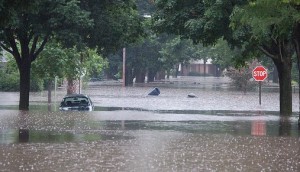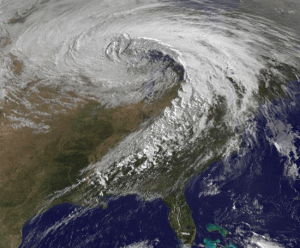
Iowa is getting used to extraordinary floods, such as these in 2008, but "extraordinary" doesn't begin to cover what could happen to California. Soon. (USGS photo)
Imagine the chagrin if, after all these years spent staring at the San Andreas Fault, waiting for the most-predicted, -costly and -deadly natural disaster in US history, Californians should instead be washed away by a flood of Biblical proportions. According to the US Geological Survey (the people who have studied the San Andreas most intensely) it could happen. They calculate that such a flood, not unprecedented in California, could dwarf the damage of even a magnitude 7.8 earthquake, otherwise known as “The Big One.”
We are getting used to the idea of floods of Biblical proportion occurring in places other than Bangladesh, where they have become virtually annual events. This month (January, 2011) alone has seen vast flooding in Australia (its most expensive natural disaster ever), Brazil (the deadliest ever, nearly 800 dead), Sri Lanka (a once-in-100-years event), South Africa (worst in 30 years) and the Philippines (40 dead, half a million displaced).
We have even become accustomed to abnormal, devastating flooding in the United States: New England last spring, Iowa in March, Nashville in May, Oklahoma City and Arkansas (20 dead) in June, Milwaukee in July, Iowa in August, Minnesota in September, North Carolina in October and, yes, California in December.
But to understand what could happen to California, and how a flood could be more destructive than a major earthquake, you have to go back to 1861. That is the last time there occurred what meteorologists archly refer to as an “ARkStorm” or an atmospheric river storm (they could have called it Noachian, but people would have had to look it up). In 1861 into 1862, it rained in California for 45 days, turning the Central Valley into a lake, wiping ut one third of the state’s real estate and bankrupting the government. According to Lucy Jones, chief scientist of the USGS Multi-Hazards Demonstration Project, “We think this event happens once every 100 or 200 years or so, which puts it in the same category as our big San Andreas earthquakes.”
When the USGS ran a scenario on the impact such a storm would have on California today, the results were awesome — as in shock and awe. 117 scientists, engineers, public-policy experts and insurance experts aided by sophisticated computer mapping and modeling came up with the following numbers: :
- Nine million homes flooded
- 600 square miles of the Central Valley under water.
- $300 billion in property damage.
- $100 billion more in agricultural losses.
- $325 billion more in business interruption losses.
- 1.5 million refugees.
- Thousands of miles of levees and flood control devices submerged.
- Many months to restore power, water, sewer and other lifelines.
- Decades to repair the damage
USGS Director Marcia McNutt called the scenario “hypothetical but very plausible.”
What she did not say directly, but was implicit in the USGS warning, was that global climate change is rapidly raising the probability of this and other disasters. Last year there were two monster storms, with the size and power of tropical hurricanes, in the mid-latitudes. On October 26 a weather station in Minnestoa reported the lowest barometric pressure (28.2 inches or 955 millibars) ever recorded in the interior United States, as hurricane-force winds lashed eight states. Could a superstorm happen here? It already has.
The USGS is urging California to “prepare” for the eventuality, as it urges earthquake preparedness. But California isn’t going to prepare, because it doesn’t have enough money to pay the light bill in the governor’s mansion. And any preparation it would make would be insufficient.
As argued in Brace for Impact: Surviving the Crash of the Industrial Age by Sustainable Living, it is not possible to save everybody, but it is a simple matter to save anybody who wants to be saved: get the hell out of California (and don’t move to Minnesota).
